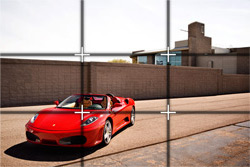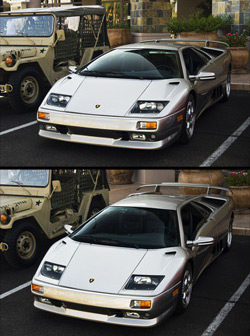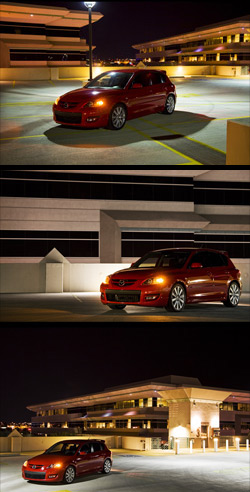While part natural ability, photography, like many things, is largely knowledge and persistence. In this case, natural ability is the photographer’s artistic vision and eye: their ability to look at objects and a scene and compose them in a way that is interesting and appealing. While lucky few are born with this ability, fortunately for the rest of us, most of it can be learned and much of it comes with experience. However, compositional understanding isn’t the only important knowledge for a photographer. Understanding how the camera’s settings, the environment’s lighting and any number of other things will affect a shot is equally important. The other most important part of the puzzle is persistence: simply getting out there, trying new things and taking photos. The number of photos I’ve taken over the past several years is well into six digits and I’m still learning new things and improving my abilities almost every time I get the camera out. If I didn’t feel like I was, I would stop taking photos.
You may have noticed that I didn’t mention photography equipment as part of the equation. While quality gear will improve the photos of a quality photographer, far too often people fall prey to the notion that good photos come from good equipment while in reality, good photos come from good photographers. Put a knowledgeable, quality photographer with a cheap point-and-shoot up against a complete novice with $10k in full-frame digital gear and have them shoot the same scene. The better shot will come from the point-and-shoot every time. Besides, these articles aren’t intended to pixel-peep, complain about autofocus hunting or help you decide if you should go Canon or Nikon. With this series of articles I intend to pass on a little of what I’ve learned over the years, increase both your compositional and technical knowledge, explain things in a way that’s easy to understand and, hopefully, convince you to go out and take some photos.
Regardless of the situation, subject or what you’re shooting with, there are a number of often overlooked, simple things that can drastically improve your photos. The three of these that I’m going to address in this article and how they directly apply to automotive photography are: the rule of thirds, being aware of your background and varying your photo height.

1. “Good things come in threes”
Often overlooked by beginners, but apparent once pointed out, the rule of thirds plays a big part in great compositions. Googling “rule of thirds” yields almost a quarter-million results and is one of the most common pieces of advice given to novice photographers and for good reason. Applying to all visual arts and appearing as early as the late 1800s, the rule states that an image should be viewed with a pair of horizontal and a pair vertical lines placed parallel and equal distances apart, dividing the image into 9 equal parts. Points of interest should be placed on these lines and/or their intersections. This generally creates a more dynamic, appealing image that tends to create movement in even static images and draws your eye to and throughout the image more than if the objects were centered. However, as is the case with all rules, there are
|
 |
exceptions. The rule of thirds should be considered a guide to improve your art, not a rule to hold you back. There are certainly instances where photos may be improved by not placing the objects based on these conventions. For example, centering an object can work well in situations where you’re going for a very geometric, rigid look and can work well when dealing with reflections and symmetry. Generally speaking, it’s important that when taking this kind of shot that the object is very much centered. When taking a direct profile shot of a car, for example, try to be completely perpendicular and centered to the wheelbase or body of the car. Having the car just slightly angled, but still centered often looks unintentional and can give undesirable results.
Which line and/or intersection your objects and point of interests should be placed on will be determined by the individual scene and composition, but generally speaking, with automotive photography I think of how the vehicle would be traveling and what kind of movement or tension the positioning creates. While much of automotive photography is static shots, the very nature of automobiles is movement and this should be kept in mind in nearly all situations.

2. “Sir, I believe there is a tree growing out of your car”
It seems so obvious when pointed out, but it’s amazing how many photos I come across that are generally well composed, technically spot on, but there it is… a lamp post sticking right out of the roof of the car. Telephone poles, stop signs, palm trees…all things that many people get so used to seeing in their daily life that they become almost invisible, even when composing a photo. While in many locations, especially outdoor car shows, these things are everywhere and unavoidable, where exactly they are in your shot is up to you. More often than not, a simple move of a few feet to the left or a slight bend of the knees can reposition such objects to a place where they’re less obtrusive. Nothing kills the lines of sleek Ferrari or Lamborghini quite like a garbage can jutting out of the engine bay. With car shows, sometimes these objects are people and can be even more unmovable. In these cases, patience is a virtue and, with any of these objects, a little Photoshop can go a long way. There will be situations where almost everything is perfect, but there’s just that one tree sticking out, ruining everything. It is times like this that your best option, if possible, is to just take the shot and worry about it later. Worst case scenario, you have a good shot with a less than ideal distraction or you wasted a few megabytes on your card (or a frame of film, if that’s how you roll).
|
 |
3. “So THAT’S why kids love sports cars”
Nothing is more stale than 150 car show shots taken from ¾ at standing head height. Fine if you’re selling cars on eBay, not so great if you’re trying to create photography that keeps people looking. This is especially true when shooting around 50mm, but that’s another article. Varying your height not only gives your photography some variety, but it can create perspectives that you don’t see in everyday life, making for more interesting compositions. A change of just a few feet up can allow you to see details you might normally be able to see or a few feet down can give a high performance sports car an even more aggressive appearance.
In addition to how height can affect the appearance of your subject, it can play an equally important role in its surroundings. Dropping the camera a few feet is often enough to allow the vehicle to block distracting shorter objects, such as people, bushes or distant stop signs. Raising the camera can eliminate the distractions caused by taller objects by raising the horizon in the frame, blending the object into the rest of the background.
When possible, I bring a small stepladder to any event at which I plan on taking a large number of photos, especially if I’m not sure what the surroundings will be like. At only about 3x2 feet in its folded form, it fits into virtually any car and can be carried and stored easily at events, but still allows for a significant increase in height, especially when couple with outstretched arms. However, there are generally plenty of objects at events that will allow you to shoot from a new perspective. I’ve been known to stand on top of walls, poles, electrical boxes, small children… whatever it takes to get the shot.

Remember that while rules of thumb and tips such as these will generally improve your photos, they’re just that. Rules of thumbs and tips. Never let “rules” and convention stifle your creativity and always take the shot that you like. After all, if you don’t like your own photos, who cares what others think?  |

